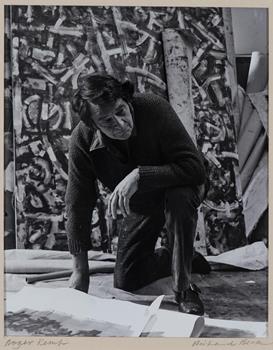BLUE DIMENSION, 1973 (also known as 'WHOLE')
ROGER KEMP
synthetic polymer paint on canvas
171.0 x 175.5 cm
signed and dated verso: Roger Kemp. / Australia / 1973
signed and inscribed with title on label verso: WHOLE / Roger Kemp
bears inscription with title on stretcher bar verso: WHOLE
Realities Gallery, Melbourne
Tolarno Galleries, Melbourne
The National Australia Bank Art Collection, acquired from the above in 1976 (label attached verso)
Roger Kemp, Realities Gallery, Melbourne, 4 – 28 May 1976, cat. 3 (as ‘Blue Dimension’)
The Seventies: Australian Paintings and Tapestries from the Collection of National Australia Bank, National Gallery of Victoria, Melbourne, 15 October – 28 November 1982
The Seventies: Australian Paintings and Tapestries from the Collection of National Australia Bank, Geelong Art Gallery, Victoria, 30 April - 29 May 1988
Lindsay, R., The Seventies: Australian Paintings and Tapestries from the Collection of National Australia Bank, The National Bank of Australasia, Melbourne, 1982, pl. 52, p. 65 (illus.)
Taylor, P., Anything Goes: Art in Australia 1970 – 1980, Art & Text, Melbourne, 1984, p. 44 (illus.)
Heathcote, C., The Art of Roger Kemp: A Quest for Enlightenment, MacMillan, Melbourne, 2007, p. 259
210760.jpg

Roger Kemp looms large in the history of twentieth century Australian art. Built around the fundamental geometric forms of the circle, the square and the cruciform, his bold abstractions are distinctive among the work of his peers. Richly infused with gesture, layered colour and texture, they simultaneously reveal the unique vision and hand of the artist, as well as the physicality of his process. Kemp’s purpose also set him apart. There is no narrative in his work, no obvious figuration or representational aim. He sought instead, to express a deeper meaning through his art, a personal perspective ‘that alluded to the timeless and universal, a means to articulate his experience of a higher truth.’1
At the end of the 1960s, Kemp and his family spent two years living in London. Working in a studio at S.P.A.C.E., a Victorian warehouse on the Thames, he was part of a community of committed, professional artists, some of whom shared his interest in abstraction, including fellow Australian, Peter Upward, and the renowned British Op artist, Bridget Riley. The space was vast and the scale of Kemp’s work increased accordingly. Often working on mural-like lengths of paper stapled to the wall, he used thick brushes and rollers to create monumental compositions, working freely, ‘without traces of mannerism, artifice or guile… There was no apparent struggle, no erasures or revisions.’2 Christopher Heathcote describes his working method, explaining that he would make a free preparatory sketch in pencil or conté to outline the composition before taking up his brush and improvising. Working throughout the day, he would continue to paint as it got dark, removing his glasses and working intuitively, ‘the composition was something felt… that had to be externalised. As long as he could tap a rhythm from within, he would keep working.’3
Dedicating himself to painting full-time from 1966, the 1970s was an important decade in Kemp’s career, which saw his practice widely acknowledged. His work was included in the inaugural Sydney Biennale (1973), he was awarded an OBE for services to Australian art in 1977, and in 1978, a group of works was acquired for the developing national collection. By this time, Kemp had also established a strong relationship with Marianne Baillieu, who ran Realities Gallery in Melbourne, and she ably and energetically championed his work, presenting it in successful commercial exhibitions and placing it in significant private and public collections. Blue Dimension, 1973, was included in his 1976 solo exhibition at Realities and shows Kemp working at his prime. A familiar geometry creates compositional structure – all outlined in black, a cruciform, series of small circles and a patchwork of rectangles are juxtaposed at various angles – but no single element takes precedence over another. Instead, each form is carefully balanced against the next, vibrating with movement and bringing the picture to life in a way that echoes the expressive energy of its painterly creation.
1. Heathcote, C., A Quiet Revolution: The Rise of Australian Art 1946 – 1968, Text Publishing, Melbourne, 1995, p. 7
2. See Heathcote, C., The Art of Roger Kemp, Macmillan, Melbourne, 2007, p. 140
3. Ibid., p. 142
KIRSTY GRANT
